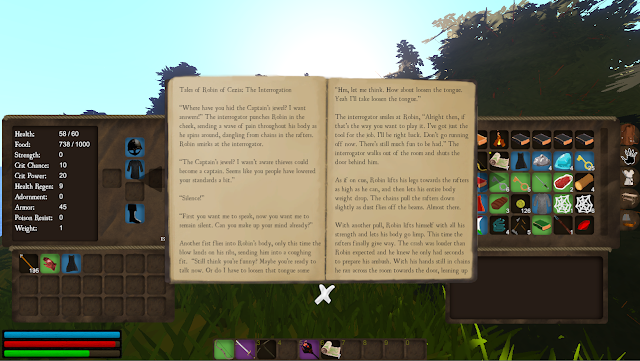Salt Game Design: RPG Elements
Hey everyone!
We are still hard at work on getting the foundational system in place for multiplayer. As we've mentioned before, the multiplayer update is going to take a while but we will keep you up to date throughout the process. Right now, John has been hard at work setting up a system for efficient communication of information between clients and making sure we set multiplayer up to run as optimized as possible.
Over the next few weeks I'd like to talk about some of the game design principles behind Salt and why the world of Salt is designed the way it is. Today I want to talk particularly about the role playing elements in Salt, and how we use those to add more adventure into the game.
Loot, Loot, and More Loot
If you've ever played many RPG's, you'll know that loot is often a large aspect of the game. Finding rare items, upgrading your gear, and searching for that legendary weapon has become a staple of many RPG's today. This aspect of game design has always appealed to us and we knew early on that we wanted to incorporate it into Salt. Although Salt is a game primarily focused on exploration, we wanted players to have a reason to explore beyond mere discovery. This is where loot came into play.
Items in Salt are separated into five rarity categories: uncommon, common, rare, epic, and legendary. This rarity is reflected in the color of the item so that there is an instant visual cue for the loot if you open a chest or loot an enemy. The rarity of an item is also reflected in its stats and abilities. Usually the rarer an item, the more powerful and valuable it is.
We've done our best to add in a ton of different armor sets, weapons, and other items in the game of various rarities so you are always left wondering if you've found them all.
Quests
Another RPG element that we've always been a fan of are quests. Quests can provide a linear sense of objective in an other wise open world. In Salt, we've included side quests and a main story quest for players to experience. Completing quests gives the player some unique rewards that can't be obtained elsewhere. Side quests are mainly short missions given by merchants that have various rewards whereas our main quest line involves boss fights and gives hints to the lore behind the world.
We did feel it was important however to leave quests as an optional aspect of the game. One of our early design philosophies was what we called playstyle focus, which essentially just means that we wanted to players to be able to play the game the way they wanted. So if quests are your thing, they are there for you to experience, but you are also free to pick a direction and sail free of any constraints.
Bosses
Along the lines of loot and rewards, we wanted to include bosses as well. There's nothing quite like fighting a difficult boss and looting a really rare weapon or piece of armor. We've included multiple bosses in Salt of various types of difficulties. Some are even fairly secret and difficult to find, but of course rewarding should you find them.
Lore
Last but not least, we wanted Salt to have lore. Because of this, we have chocked the game full of lore books. Some books are relevant to the backstory of the world, while others are merely stories of adventurers and travelers. Lore is one of those things that is easy to pass up but should you dive into it, it can add a sense of depth to the game that previously wasn't there. We even try to reward players for reading lore by included crafting recipes and hints to secrets in some of the books.
Overall, we feel like Salt has a lot of fun RPG elements and we hope that you all enjoy them as much as we do! We'd love to hear your feedback on the RPG elements in Salt and perhaps even some RPG themed ideas you'd like to see added into the game?
- Will Sterling (Game Design and Sound Lead)







3 comments: